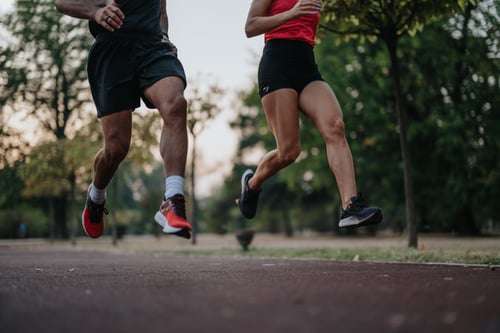It’s tempting to pick out running shoes (or any other sneakers) based on looks alone, but that’s not what’s best for our feet: and just because your running buddy RAVES about how great her new pair of running shoes are doesn’t mean they are going to be the best pair for you, too. Most people don’t realize the importance of investing in the right pair of running shoes, much less how to find the one that is right for them.
Here are several things you need to take into consideration when trying to find the running shoe that works best for you:
Your Fitness Level
The amount of cushioning, stability and performance durability is different based on how experienced a runner you are and much mileage you rack up per week. Beginning (low-mileage) runners should get a shoe that offers more protection to lessen the risk of injury while they are still adjusting to running and perfecting their form. Medium-mileage and high-mileage runners will have differing needs.
Injuries — Past and Present
If you have any current injuries, you may need a certain type of running shoe to help support or alleviate that injury until it heals. If you have a history of running-related injuries, you can find the best kind of shoe to help prevent any future injuries.
Your Running Gait
This is probably the most important aspect of choosing the right running shoe. If your alignment is off, you need the right style of shoe to help correct it so as to minimize risk of injury. There are three different types of running gaits: neutral (which is normal), overpronated and underpronated. Overpronation is when your foot rolls inward. A stabilizing shoe is best for this kind of gait. Underpronated is when your foot rolls outward. This running gait benefits from a shoe with more cushioning. Not sure what type of running gait you have? Take the Wet Test to find out.
How the Shoe Fits
You should always size up when purchasing running shoes: anywhere from half to a full size bigger than you typically wear in everyday shoes. Your feet swell, expand and slam forcefully forward when you run. It’s important to have at least a thumbnail’s length of space in the front of the shoe so your toes aren’t slamming into the front of the shoe. Not having the right fit can lead to blisters and blackened toenails.
Midsole Cushioning
We tend to choose shoes based on colors and outer shell, but what we really need to be looking at is the midsole cushioning — the foam layer that provides cushioning between your feet and the road. This layer is what absorbs the shock for your feet and helps protect your foot from anything hard or sharp.
How They Feel
We’re all different and we all like different levels of cushioning in our running shoes. Take your time and walk around the store in the shoes you’re considering. Make sure you really like the way they feel because, if you don’t like them when walking, you probably won’t like them when running either.
If you are unsure of how to purchase the correct running shoe, visit a specialized running and fitness store, like Luke’s Locker, where experts can ask you questions and assess your running style in order to help you find the best match.
If you already know your running gait, you can use this Shoe Finder for recommendations on a good running-shoe match for you.
If you have a running-related foot or ankle injury that you need looked at, please contact Sweeney Foot & Ankle Specialists at one of our two convenient locations in The Woodlands or Magnolia, or visit our website to schedule an appointment.








